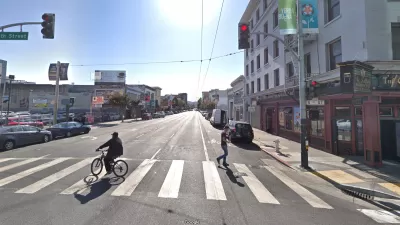Actually, dooring (motorist or passenger exiting car opens door on passing cyclist) might still occur, but the driver would have to watch for passing cars, not cyclists, as the bike lane would be placed between the parked cars, buffer and the curb.
A pilot project has been authorized for Golden Gate Park by the San Francisco Municipal Transportation Agency along John F. Kennedy Drive to enhance cyclist safety. If successful, it could be applied city-wide. The striped buffer lanes are already in use in NYC.
"The $250,000 project will move parking spots away from the curb so bicyclists and cars no longer have to mingle on the roadway. The lanes are expected to protect bicyclists and encourage more cycling in The City."
"A painted buffer area between the parked cars and bikeway will provide space for passengers to enter and exit vehicles," the SFMTA said. "In areas without parking, the bikeway will be separated from the travel lane by a painted buffer area only."
"The lanes have been a success in Amsterdam, Copenhagen and New York City, said Andy Thornley, the San Francisco Bicycle Coalition's" program manager. The lanes offer the comfort of safety and fluidity for cyclists, he said."
Correspondent's Note: The article does not include the width of the striped buffer lane, but it certainly will be wider than the single stripe provided by conventional bike lanes.
Thanks to MTC Headlines
FULL STORY: New bikeways create buffer

Manufactured Crisis: Losing the Nation’s Largest Source of Unsubsidized Affordable Housing
Manufactured housing communities have long been an affordable housing option for millions of people living in the U.S., but that affordability is disappearing rapidly. How did we get here?

Americans May Be Stuck — But Why?
Americans are moving a lot less than they once did, and that is a problem. While Yoni Applebaum, in his highly-publicized article Stuck, gets the reasons badly wrong, it's still important to ask: why are we moving so much less than before?

Research Shows More Roads = More Driving
A national study shows, once again, that increasing road supply induces additional vehicle travel, particularly over the long run.

Judge Halts Enforcement of Anti-Homeless Laws in Grants Pass
The Oregon city will be barred from enforcing two ordinances that prosecute unhoused residents until it increases capacity and accessibility at designated camping sites.

Advancing Sustainability in Los Angeles County Schools
The Los Angeles County Office of Education’s Green Schools Symposium brings together educators, students, and experts to advance sustainability in schools through innovative design, climate resilience strategies, and collaborative learning.

Using Old Oil and Gas Wells for Green Energy Storage
Penn State researchers have found that repurposing abandoned oil and gas wells for geothermal-assisted compressed-air energy storage can boost efficiency, reduce environmental risks, and support clean energy and job transitions.
Urban Design for Planners 1: Software Tools
This six-course series explores essential urban design concepts using open source software and equips planners with the tools they need to participate fully in the urban design process.
Planning for Universal Design
Learn the tools for implementing Universal Design in planning regulations.
City of Moreno Valley
Institute for Housing and Urban Development Studies (IHS)
City of Grandview
Harvard GSD Executive Education
NYU Wagner Graduate School of Public Service
City of Cambridge, Maryland
Newport County Development Council: Connect Greater Newport





























